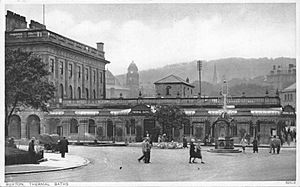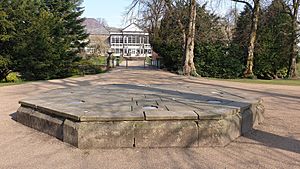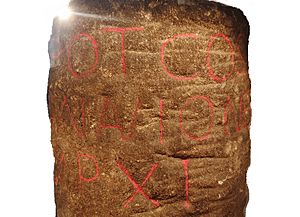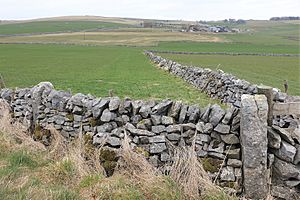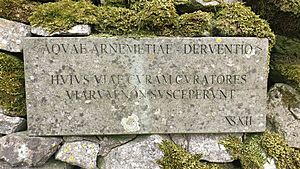Aquae Arnemetiae facts for kids
Aquae Arnemetiae was a small Roman town in ancient Britain. It was special because it had natural warm springs. The Romans lived there from about 75 AD to 410 AD. Today, this place is known as Buxton, in Derbyshire, England.
The name Aquae Arnemetiae means 'Waters of Arnemetia'. Arnemetia was a goddess worshipped by the Romans and native Britons. She was linked to sacred groves, which are like special forests. Around 700 AD, the town was listed as Aquis Arnemeza in an old book called the Ravenna Cosmography. This book listed all known places in the world. Aquae Arnemetiae was connected by roads to other Roman forts and towns like Navio (near Brough), Ardotalia (near Glossop), and Manchester.
Contents
Roman Life in Aquae Arnemetiae
The Roman Baths
Aquae Arnemetiae and Aquae Sulis (which is now the city of Bath) were the only two Roman towns in Britain famous for their baths. The Romans built a large bathhouse right where the warm spring water came out of the ground.
Later, in the late 1600s, people found parts of the old Roman bath. They found a smooth stone bath and a lead tank. When the Crescent hotel was built in 1780, more Roman bath parts were found. Today, the original Roman bath is buried under the Crescent, next to the Natural Mineral Baths building.
In 2005, during building work, archaeologists found the entrance and doorways to the Roman baths. They also found a wall that might have been part of a palaestra, which was an exercise hall. More discoveries were made between 2009 and 2012, including underground tanks and a large iron cauldron.
In the 1970s, when the main spring was dug up, a special collection of 232 Roman coins was found. These coins covered 300 years of Roman rule in Britain. People often threw coins into sacred waters to ask the gods for good luck. These coins, along with some bronze jewellery, are now on display at the Buxton Museum.
The warm spring water comes from about 1 kilometer (0.6 miles) underground. About a million liters (264,000 gallons) of water flow out every day! The water is always a steady 27 °C (80 °F). Scientists have studied the water and found it has a lot of magnesium. They also think the water started its journey underground about 5,000 years ago.
The Roman Town
It's possible that Emperor Hadrian visited Aquae Arnemetiae in 122 AD. He might have been on his way to another Roman town called Wroxeter.
In 1787, a man named Major Hayman Rooke found a long section of the Roman town wall. This wall is now buried under a landscaped hill called The Slopes. At the same time, Rooke also found details of a temple base in the same area. This temple overlooked the baths and springs. It was dedicated to Arnemetia, the water goddess. The temple had a special room for worship and a front porch with columns.
In 1860, records show that a Roman macellum (a covered market with an open central area) and floor mosaics were found. These were on the west side of Buxton's market place.
An old Celtic temple was found at the Bath Gardens site in 1755. It had an eight-sided base and a faint inscription that looked like 'Aeona'. People thought it was dedicated to Epona, the goddess of horses, or more likely Apona, the goddess of healing waters. Sadly, when the Pavilion Gardens were redesigned in 1871, this 2,000-year-old temple was taken down. Only its base remains today.
About a mile south of the town, there was a Roman farm at Staden. Digs in the 1980s found platforms of buildings, walls, and old fences. They also found grinding stones, pottery, animal bones, and jewellery. One piece of pottery showed it was made between 100-130 AD. A special tile found at the farm showed that the farmhouse even had underfloor heating!
Roman Discoveries
In 1862, a Roman milestone was found in the Silverlands area of Buxton. It's the oldest inscribed milestone found in Derbyshire. The writing on it says it's 11 miles from Navio. Navio was a Roman fort near the village of Brough.
In 1903, an archaeologist named Micah Salt dug in the Silverlands area. He found many Roman items, including a silver coin, tiles, leather sandals, stone fireplaces, glass, and many pieces of fine Roman pottery. Some pottery showed it was made between 60-100 AD in a place called Verulamium (modern St Albans). The milestone and other Roman items are now at the Buxton Museum.
Many Roman remains were also found in 1811 when Buxton's Town Hall was built. This was at the north end of the market place. Close to the Town Hall, Roman floor slabs were found in a cellar in 2006. You can still see large Roman stone work at 8A Hall Bank.
Roman coins and bronze jewellery were also found in nearby Poole's Cavern in 1865.
A stone altar dedicated to Arnemetia was found in 1903 at the Navio fort. The writing on the altar says, "To the goddess Arnomecta, Aelius Motio gladly, willingly, and deservedly fulfilled his vow." This altar is also on display at the Buxton Museum.
Roman Roads Around Aquae Arnemetiae
Aquae Arnemetiae was an important meeting point for two main Roman roads: Batham Gate and The Street.
Batham Gate means "road to the bath town" in Old English. This Roman road went from Templebrough Roman fort in South Yorkshire, past Navio Roman Fort, and then to Buxton. Part of this old Roman road on Tideswell Moor is now a protected historical site. This road was very important for getting to lead mining areas in the Peak District. There is still a road called Batham Gate road heading east out of Buxton today.
The Street road (also known as Margary Number 71a) came from Derventio (which is now Derby) to Aquae Arnemetiae. Parts of today's A515 road south of Buxton follow this old Roman route. "The Street" is still the name of a road in the Upper Goyt Valley. This road might have connected Buxton with Condate (Roman Northwich). There's a plaque in a stone wall near The Street road that marks the Roman road from Buxton to Derby. It also has a funny inscription that translates to: "The road menders have not taken care of this road."
Roman roads also went north from Buxton to Mamucium (Manchester) and to Melandra fort, near Glossop. Parts of these northbound roads have been found and dug up. There was also a Roman Road (Margary Number 713) between Buxton and Leek. This road joins the modern A53 road towards Leek at Morridge Top.
Because so many roads met at Aquae Arnemetiae, a historian named Edward Tristram thought in 1916 that there might have been a Roman fort in the town. He thought it might have been south of the market place, near the current Bath Road.
The Navio fort helped protect the route northwest to the larger Melandra fort. A large inscribed stone, called a Centurial stone, was found at Navio in 1903. It dates from when the fort was rebuilt in 154 AD by soldiers from southwest France. This Centurial stone is also on display at the Buxton Museum.
Even today, some OS maps still mark Buxton with its old Roman name, Aquae Arnemetiae.
Images for kids


